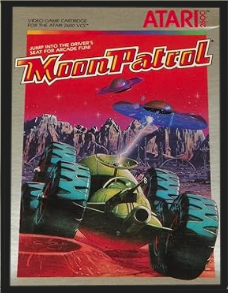

In the vast universe of video gaming, certain titles stand out for their pioneering gameplay, iconic status, and the indelible mark they leave on the industry and its fans. Among these, the Moon Patrol video game, released in 1982, occupies a special place. As a significant part of video game history, Moon Patrol is more than just a relic of the past; it’s a testament to the innovation and creativity of early game developers. In this post, we’ll delve deep into the legacy of this arcade classic, exploring its origins, gameplay, cultural impact, and enduring appeal.
The Birth of Moon Patrol and Its Innovations
When Moon Patrol hit the arcade scene in 1982, it immediately distinguished itself from other video games of its time through its inventive features and gameplay.
Developed by Irem and brought to the American market by Williams Electronics, Moon Patrol was more than just a side-scrolling shooter; it was a forerunner in utilizing parallax scrolling. This technique gave the moon’s barren landscape a multi-layered, dynamic feel, significantly enhancing the game’s visual depth and creating a more immersive experience for players.
Furthermore, Moon Patrol introduced gamers to a novel, continuous gameplay model that was segmented by checkpoints. This was a departure from the more common level-based structure seen in games of that era.
Each segment of the lunar terrain was marked by a letter, providing a clear progression system that kept players engaged and motivated to reach the next checkpoint. This continuous journey across the moon’s surface, fraught with obstacles and enemies, represented a seamless adventure that was both challenging and rewarding.
These innovations were not just technological achievements; they were pivotal in shaping player expectations and the development of future video games. Moon Patrol’s design choices—its pioneering use of parallax scrolling and a checkpoint-based progression system—did not merely contribute to its own success.
They laid the groundwork for the evolution of video game design, influencing a wide range of games that followed. Moon Patrol, thus, stands as a milestone in the history of video gaming, marking a moment when the medium took a significant leap forward in terms of both technology and gameplay.
Understanding the Gameplay Mechanics
In Moon Patrol, players assumed the role of a lunar rover patroller, navigating a hazardous moonscape teeming with obstacles. The game’s controls were intuitive yet demanded a high level of skill, as players had to maneuver their vehicle over craters, rocks, and explosive mines that littered the ground. The challenge was twofold: not only did players need to safely traverse the terrain, but they also had to fend off aerial assaults from UFOs and missiles, adding an extra layer of difficulty to the gameplay.
The rover was equipped with dual-directional cannons, allowing players to shoot obstacles directly ahead or targets above, a mechanic that required players to constantly balance offensive and defensive actions. This innovative approach to gameplay emphasized the need for strategic planning and quick reflexes, as the game’s pace rarely allowed for a moment’s respite. Players needed to anticipate threats from all directions, making every second of gameplay a thrilling test of their abilities.
Moreover, the act of jumping over obstacles introduced a timing element to the gameplay. Misjudging a jump could lead to a catastrophic collision, forcing players to start over from the last checkpoint.
This made the game not only a test of shooting skill but also of precision and timing. Each obstacle overcome and enemy defeated offered a satisfying sense of achievement, driving players to push forward, despite the game’s relentless challenge. This harmonious blend of shooting, driving, and strategic maneuvering set Moon Patrol apart, making its gameplay mechanics a memorable and influential element of its enduring legacy.
The Cultural Impact of Moon Patrol
Moon Patrol not only revolutionized the video game industry with its gameplay mechanics but also left a significant mark on the cultural landscape of the 1980s. As players crowded around arcade machines, entranced by its parallax scrolling and engaging challenges, Moon Patrol became more than just a game; it was a phenomenon that captured the essence of competitive arcade gaming.
The presence of a leaderboard fostered a spirited atmosphere of rivalry and camaraderie, with players returning time and again in attempts to etch their names among the high scores. This competitive edge contributed to the game’s popularity, making it a staple in arcades and a topic of conversation among gaming enthusiasts.
Its influence permeated through the decade, inspiring a generation of game developers and players alike. The game’s success illustrated the potential of video games as a form of entertainment that could captivate audiences, spurring a wave of creativity in the industry. Titles that followed borrowed elements from Moon Patrol, from its scrolling landscapes to its checkpoint progression, showcasing its lasting impact on game design.
Moreover, Moon Patrol became emblematic of the era’s burgeoning video game culture. It was a hallmark of the arcade golden age, representing a time when gaming began to take center stage in popular culture. The game’s distinctive soundtrack and visuals became iconic, encapsulating the vibrancy and innovation of 1980s arcade games. As such, Moon Patrol didn’t just contribute to the evolution of video game mechanics; it also played a pivotal role in shaping the cultural identity of an era, leaving an indelible mark on the hearts of those who experienced its lunar adventure firsthand.
The Challenge and Reward System
Moon Patrol’s unique challenge and reward system is a cornerstone of its appeal, blending the thrill of obstacle navigation with the satisfaction of enemy annihilation. Each obstacle surmounted and foe vanquished felt like a personal triumph, encouraging players to delve deeper into the moonscape’s mysteries. This delicate balance between difficulty and achievability made Moon Patrol irresistibly replayable.
Central to this system was the innovative use of checkpoints, dividing the game into manageable segments identified by letters. This approach not only provided players with immediate short-term objectives but also infused a sense of progress and accomplishment, even in the face of frequent setbacks. The game’s design cleverly capitalized on the human desire for achievement and recognition, making the journey from checkpoint to checkpoint both a challenge and a compelling incentive to persevere.
Additionally, Moon Patrol’s difficulty was finely tuned to avoid frustration while still presenting a formidable challenge. Players found themselves constantly adapting, strategizing, and improving. This skill progression—learning to anticipate obstacles, perfecting timing, and refining enemy engagement strategies—was key to the game’s addictive nature. Each playthrough offered the opportunity to get just a little bit further, to surpass previous achievements, and perhaps most enticingly, to climb the leaderboard.
In essence, Moon Patrol’s challenge and reward system was a masterclass in game design, offering an experience that was as rewarding as it was challenging. It exemplified how a game could captivate and maintain player interest through a finely calibrated blend of obstacles and achievements, setting a precedent for many games that followed.
Moon Patrol’s Enduring Legacy
Over the years, Moon Patrol’s influence on the video game industry and its community has remained steadfast. Recognized as a pioneer for its technical and design innovations, the game has maintained its relevance through various re-releases across multiple platforms, ensuring its accessibility to both nostalgic players and curious newcomers alike. This accessibility has played a crucial role in bridging generational gaps among gamers, allowing the spirit of the early 80s arcade era to thrive in the modern gaming culture.
The legacy of Moon Patrol transcends its original arcade form, serving as an educational touchstone for game developers and a cherished memory for players. Its implementation of parallax scrolling and checkpoint progression has been analyzed in game design studies, highlighting its contributions to the evolution of video game mechanics. Additionally, its presence in discussions around game design and history underscores the respect and admiration it commands within the industry.
As retro gaming continues to enjoy a resurgence, Moon Patrol finds new life in collections and digital downloads, resonating with audiences who seek the charm and challenge of classic games. Its inclusion in these compilations not only celebrates its historical significance but also introduces it to players who might not have experienced its original arcade glory.
Moon Patrol’s lasting appeal is a testament to the creativity and innovation of its creators, proving that solid game mechanics and engaging gameplay can withstand the test of time. Its legacy is a beacon for aspiring game developers and a reminder of the enduring impact a well-designed game can have on the collective gaming consciousness.
Moon Patrol in the Modern Gaming Landscape
In an era dominated by high-fidelity graphics and expansive story-driven experiences, Moon Patrol stands as a beacon of simplicity and engaging playability. Its significance in the contemporary gaming world is reflected in the continued enthusiasm for side-scrolling games and arcade classics, which find their roots in the straightforward yet captivating design philosophy that Moon Patrol exemplified. This vintage title has seen a resurgence, riding the wave of retro gaming’s revival, showcasing its timeless charm to a new generation of gamers.
Moon Patrol’s journey through the evolving gaming landscape illustrates how fundamental gameplay enjoyment is to the medium’s appeal. As developers and players alike explore the rich tapestry of video gaming’s past, Moon Patrol remains a key reference point, demonstrating that innovation in game mechanics and player engagement can outlast any technological advancements. Its presence in digital stores, classic compilations, and even as a subject of study in game design courses, reinforces its importance and continued relevance.
This ongoing appreciation of Moon Patrol underscores a broader trend in the industry towards celebrating and preserving the classics that have shaped gaming’s identity. In doing so, it ensures that Moon Patrol, a game that once captured the imaginations of 1980s arcade-goers, continues to inspire and entertain, bridging past and present in the vast, ever-changing universe of video games. Its legacy in modern gaming is not just as a relic of a bygone era, but as a living testament to the enduring power of great game design.
Conclusion: The Timeless Appeal of Moon Patrol
Moon Patrol’s journey from a 1982 arcade classic to a beloved icon of the video game industry underscores the enduring nature of its appeal. Its innovative mechanics, engaging gameplay, and the nostalgia it invokes have cemented its place in the hearts of gamers across generations. This game illustrates that beyond the rapid advancements in technology and graphics, the core of gaming is about captivating and enjoyable experiences.
Moon Patrol’s continued relevance today, amidst a sea of modern titles, speaks volumes about the timeless quality of its design and the universal joy it provides to players. It serves as a reminder that innovation, creativity, and fun are at the heart of video gaming’s lasting legacy. As Moon Patrol navigates the terrain of the digital age, it remains a shining example of how games can transcend time, offering new and old players alike a window into the pioneering days of gaming while still delivering a satisfying challenge.
The essence of Moon Patrol’s allure lies not just in its historical significance, but in its ability to unite players through the shared experience of overcoming its moonlit challenges. In reflecting on Moon Patrol’s enduring legacy, it becomes evident that the game is more than a piece of nostalgia; it is a living testament to the enduring impact of great game design.


